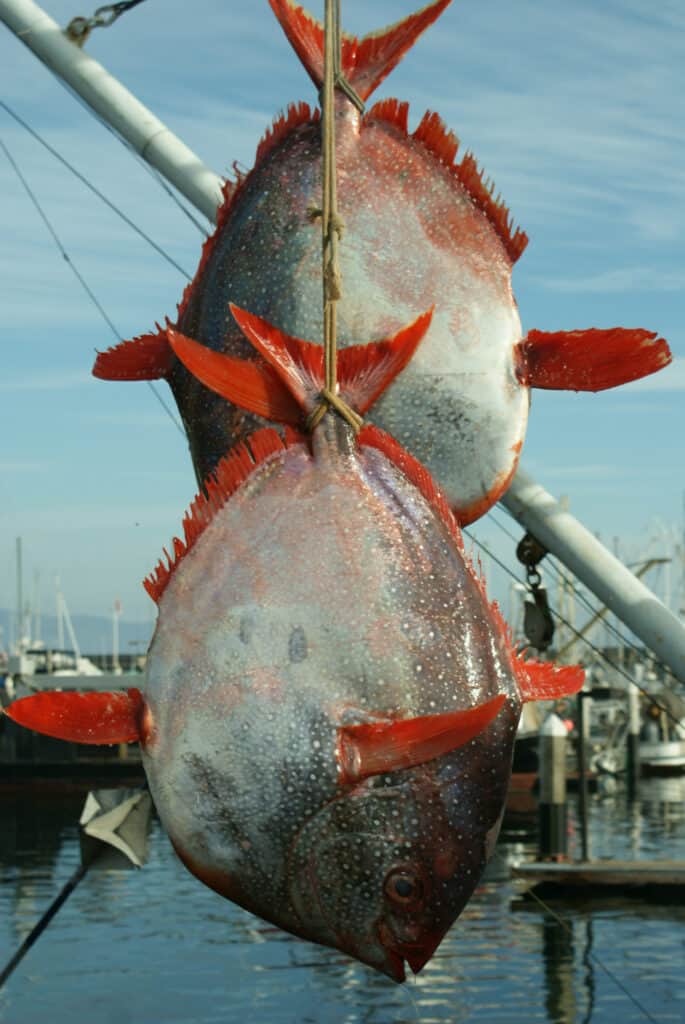Opah
Lampris guttatus
Opah are brightly colored, with red-orange fins and a silvery body.
Advertisement
Opah Scientific Classification
- Kingdom
- Animalia
- Phylum
- Chordata
- Class
- Actinopterygii
- Order
- Lampriformes
- Family
- Lampridae
- Genus
- Lampris
- Scientific Name
- Lampris guttatus
Read our Complete Guide to Classification of Animals.
Opah Conservation Status
Opah Facts
- Prey
- Squid, krill, small fish
- Group Behavior
- Solitary
- Fun Fact
- Opah are brightly colored, with red-orange fins and a silvery body.
- Most Distinctive Feature
- Unique coloring
- Other Name(s)
- Moonfish, Sunfish, or Kingfish
- Habitat
- Deep ocean
The opah is a large, colorful fish that makes a prize catch and a tasty meal.
Opah are a family of large, circular fish that live mostly in tropical waters. They are brightly colored with red-orange fins and silvery bodies. They can grow up to 6 feet, making them a great catch for fishermen who enjoy deep sea fishing. If you are lucky enough to catch an Opah, serve it up fried, grilled, or sauteed for a delicious dish.
Opah Facts
- Two species of Opah are now extinct and were found in fossils that date to as long as 23 million years ago.
- Opah are also called Moonfish, Sunfish, or Kingfish.
- These fish can get up to 600 pounds and 6 feet long.
- There are six species of Opah and most live in tropical or temperate waters.
- Opah are deep sea fish and require specialized fishing gear to catch.
Classification and Scientific Name
Opah refers to an entire family of fish known by the scientific name Lampridae. They are a small family, with only six species. Nevertheless, they are still easy to recognize and make a splash among the fishing community.
In the past, only two species of Opah were recognized. Now, scientists break them down into six different species. Each lives in a different part of the world. These species include:
- Lampris australensis
- Lampris guttatus, also called the North Atlantic Opah
- Lampris immaculatus, also called the Southern Opah
- Lampris incognitus
- Lampris lauta, also called the East Atlantic Opah
- Lampris megalopsis, also called the Bigeye Pacific Opah
There are also two extinct species. Scientists discovered fossilized Opah that date to the late Miocene and the late Oligocene, as early as 23 million years ago.
Opah are part of the Lampriformes order. These include other ray-finned fish and uses the root word “lampr-” to refer to the bright colors. The Opah are the most well-known fish within the order that display these bright colors. They belong to the Actinopterygii class, which includes all ray-finned fish. Over 50% of living vertebrate species belong to this class.
Opah are members of Chodata phylum and Animalia kingdom.
Opah Appearance
These fish can be quite large, often growing up to 6 feet or more. The larger species, such as Lampris guttatus, make great catches for fishermen, often weighing around 600 pounds. Even the smaller species can be as large as 3 feet. They are flat and circular, giving an almost 2-dimensional appearance.
Opah have two fins that are angled back and their caudal fin is forked. They also have two pectoral fins that extend almost perfectly horizontally away from their body. Their dorsal and caudal fins extend back in smaller rays all the way to their tail.
One of the most distinctive features of the Opah is its coloring. They are red-orange at their fins and have a silvery body with white spots. The red-orange coloring can extend into their body and give them a very interesting effect as they swim. Opah have yellow rings around their large eyes as well. They have small mouths relative to their large, flat bodies.

Opah fish are nearly circular, with their bodies being nearly as wide as they are long.
©Vanishingfin/Shutterstock.com
Distribution, Population, and Habitat
The six species of Opah are all very similar and divided mainly according to their geographic location.
Lampris australensis lives in the Pacific and Indian Oceans. They favor these warmer waters of the Southern hemisphere. Lampris guttatus is one of the best-known species of Opah. These fish can be found in the North Atlantic and the Mediterranean Sea. Lampris immaculatus, also called the Southern Opah, lives primarily in the Antarctic Polar Front. This is a vastly different environment than that of other species of Opah.
Lampris incognitus swims in the Pacific Ocean and is a popular fish for anglers in those areas. Lampris lauta is found in the East Atlantic. It can be seen in the Mediterranean Sea, like the Lampris guttatus. However, they do not often overlap territories. Lampris megalopsis lives in the Western Pacific Ocean, Gulf of Mexico, and the Indian Ocean. It is sometimes called the Bigeye Pacific Opah for both its appearance and location.
Opah keep their internal organs at a higher temperature than the outside environment. This is called endothermy. This allows Opah to live in colder temperatures when needed.
According to the National Oceanic and Atmospheric Administration, NOAA, Opah are in no danger of becoming extinct. While there is not much data available on their actual population numbers, they believe that they are plentiful enough to be considered safe. Opah often live their entire lives in the deep ocean. Fishing gear for Opah is unlikely to cause a major disturbance in their environment because it comes in contact with so few elements of their habitat.
Predators and Prey
Opah eat squid, krill, and some small fish. While Opah are large, they have small mouths and lack teeth.
Some of the biggest predators of Opah are large ocean-dwelling animals. Great White Sharks and Mako Sharks are two of the most common predators. Of course, the exact predators that go after Opah differ based on their location.
Opah also make a great fish for anglers. Many of the Opah caught in the wild make prize fish due to their size and interesting coloring. There aren’t any restrictions on the amount of Opah you can catch in most areas, although some places do require that fishermen report Opah that they catch for data collection purposes. Restrictions that do impact Opah fishing are often in place to protect other species, such as the Monk Seal in Hawaii that can become entangled in some fishing gear. Because Opah are a deep water fish, most restrictions do not apply in the areas where they live.
Reproduction and Lifespan
Not very much is known about the Opah’s lifespan or reproductive habits. Scientists believe that most of the Opah caught are between one and six years old, based on the number of ray fins that they display. They also think that Opah spawn multiple times each year. This likely results in a healthy population of Opah in the wild. They tend to be solitary swimmers and do not really swim in schools like some other species of fish.
Opah in Fishing and Cooking
They are large and brightly colored. This makes Opah a prize fish for deep sea fishermen. They are more often caught in tropical waters, such as those of the Pacific near California and Hawaii. Rarely, Opah are caught in the Atlantic. These are deep sea fish and very big, so they require specialized gear and equipment to haul them in.
There aren’t many commercial Opah fishing operations. But when caught, they make a great fish to eat. They are similar to tuna, although milder in taste. Seared Opah and grilled Opah are two popular ways to cook and eat this fish. Some parts of the Opah are very meaty and make a substantial meal.
Similar Fish to Opah
Tuna: Another large fish that is tasty to eat, tuna are better known. Opah and tuna have similar tastes.
Ono: This fish is plentiful in the Hawaiian islands, where Opah also live. Also called Wahoo, Ono are a popular fish to catch and eat.
View all 66 animals that start with OOpah FAQs (Frequently Asked Questions)
Is Opah a good eating fish?
Yes! Opah has a firm, white flesh that is similar to tuna. Some parts of the Opah are meaty and even work as a substitute for beef.
Does Opah have a lot of mercury?
Opah can have higher levels of mercury than some other fish due to its environment. Mercury accumulates as the fish ages so older Opah will have more mercury than younger Opah.
Where are Opah found?
These fish favor tropical and temperate waters. They are commonly found in the Pacific and Indian Oceans, especially off the Hawaiian islands where they are frequently fished. Some species of Opah live in colder waters, such as the Lampris immaculatus, also called the Southern Opah. This fish lives in the Antarctic Polar Front.
Thank you for reading! Have some feedback for us? Contact the AZ Animals editorial team.
Sources
- NOAA / Accessed August 5, 2022
- Hawaii Seafood / Accessed August 5, 2022
- Britannica / Accessed August 5, 2022


















